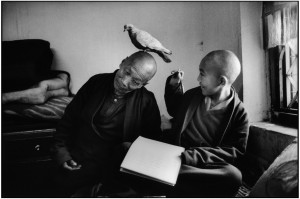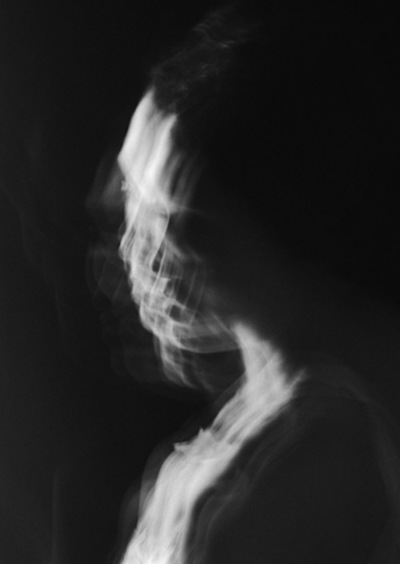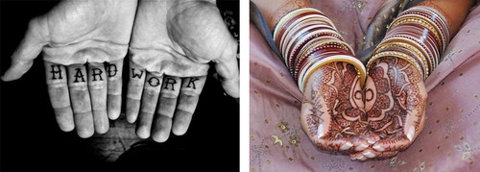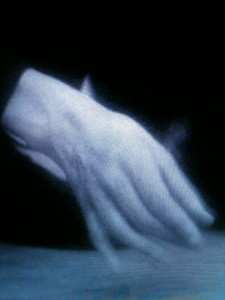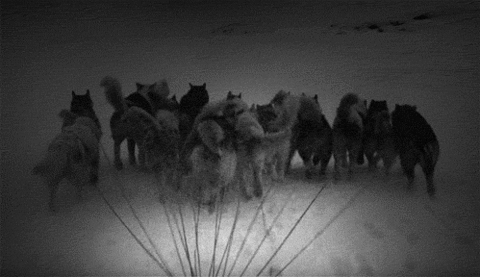.jpg)
I thought we might start with dogs, so popular this time of year, chugging their way through the parks and along sidewalks. Since I’ve started doing what the studios like to call yoga – which I like to think of as a personal beauty and glamour program – I’ve been noticing dogs. The way they speak to each other with their bodies, the way they create territories and then banish them. They make a fence around themselves with their fence barkings. This is mine this is me, and then they can dissolve this fence, just like that. I watch these dogs grasping – this is my house, my body, my territory. And then I see them release their hold. This is the second noble truth, right? That the origin of dukkha, of suffering, is grasping. I’m holding on, I’m grasping. And what am I holding onto? I’m holding onto me. I thought of that. That was my idea. Oh I know you’re going to build this new centre of anti-gravity, but what’s in it for me? What am I going to get out of it? You know I watch these dogs play together and they have this too, dog are also clinging. So often when they’re barking they’re barking out: me, don’t mess with me, don’t you step on my backyard. But then another dog comes along, and it doesn’t happen every time, but they start sniffing around, they come back to this moment, this moment here, this moment of the body, this dog body in concert, in rhythm, in a dance, with another dog body – and that grasping, that clenching, releases and lets go. In other words, they are busy living the second noble truth. Is it too much to say that they are giving me a kind of doggie dharma talk? Or better, a lived dharma, a demonstration of dharma in motion.
Stephen Batchelor says the four noble truths are not commandments. They’re not fixed and frozen laws, they are calls to action. It’s been hard for me to get my head around this, because I don’t know about you, but when I was growing up there were laws and prohibitions. You can do this, you can’t do that. You can do this sometime, you can never ever do that. My mother, my teacher, my God, the boss I have at work, the policeman flagging my bike down on the street. These are people who create the laws that appear fixed and unchanging. What is my relation to the law? As a citizen, as a brother, as a bike rider, as someone who comes to the post yoga studio of Centre of Gravity there are certain laws. I don’t even need to have them spelled out for me, I don’t need to see them written down. I can already feel them tightening my ches; this is where the law lives in me. Ok ok, I won’t ever do that again. What is my relationship to the law? The law is fixed, it’s there before I’m there, and it makes a line. And I am going to observe the line. The stop sign, the no talking rule, the no butting in. Even if I step over the line, I’m still observing the law. I know I shouldn’t be doing this… oh, I didn’t know you were married.
But the Buddha’s four truths don’t work like the law. The four noble truths aren’t scorched across the sky for all eternity. They’re not laws that need to be obeyed and followed. There’s no following. I don’t know about you, but part of the reason why I come here is because I don’t want to follow. I’m tired of singing along, and I’m tired of laws. Laws make me ache for French fries and cigarettes. Instead, each noble truth calls for a response, and the response, the way you respond, is not a law. Your response is not already written down somewhere, it’s not like you’re going to absorb the truths, the dharma, and then you’ll know what to do. Because the situation, your situation, keeps changing. What is beautiful and horrible about the Buddha’s truths is that there is no same way, no tried and true, no old faithful to rely on. Instead there is the invitation to enter this moment, this moment here and now.
As the Buddha said, within each truth there is a complex task to be performed, and only then did he become the Buddha. Here’s the four noble truths a la Stephen Batchelor.
“Anguish, the Buddha says, is to be understood, its origins to be let go of, its cessation to be realized, and the path to be cultivated. Only through knowing these truths can he claim to have found ‘authentic awakening.’ Each truth requires being acted upon in its own particular way. Understanding anguish, letting go of its origins, realizing its cessation, cultivating the path.
The first two truths (anguish and its origins) describe the dilemma, the problem, the difficulty, the second two (cessation and the path) its resolution.”
The Buddha doesn’t come around here much anymore, so what I like to do is watch dogs, dogs at play. I watch them realize the second noble truth, the one about the origins of dukkha, the origins of suffering. I can see them let go of this grasping and clinging, when they are busy being a body, as dogs so often are. They grasp their territory, the me of being a dog, and then they let go, they release their grasp. The Buddha seems so far away, such an old saintly dude in a country I’ve never visited. I don’t know much about the Buddha, I just want to be more like a dog.
Downward Dogs
I try to let these observations flow through me, flow through the animal that I am, when I’m in surya namaskara, downward facing dog. One of the great things about being in this pose, one of the great things about letting this pose inhabit me, is expressing solidarity with my new animal friends. But part of the kick, I have to admit, is that I can feel this long trail of bodies getting up into the same pose. Do you feel that? When we come together in this space, or in the places they like to call yoga studios, there’s a moment when everyone in the room is a dog. Everyone is a dog in their own way of course, this downward dog looks more like a poodle, this one looks more like a basset hound. But this collection of dogs, this pack, this scrum, this roomful – is a picture. It’s not just me, it’s not just you, in this moment, we’re all becoming dogs together. And we make a picture of all the other dogs in all the other studios and basement apartments and centres that exist without gravity. Don’t we reach back at the same time and feel in our new dog bodies the way that all those kids and women and men pushed themselves up and down into their downward facing dog bodies over all these centuries past? I follow this trail of bodies like a dog detective, leading me here, here in this moment. I can feel all of those moments as part of this moment, and it’s not an idea. I believe it’s a question of what they like to call in yoga the alignment. I believe this is an aspect of alignment, temporal alignment. My dog body aligns itself with all those other dog bodies as I reach back, and I’m not reaching back because I’m nostalgic, I don’t go into downward dog and then begin to cry misty little sentimental tears… oh I remember the 15th century, downward dogs were so beautiful then. No, I’m reaching back in order to be here. I’m aligning myself, my anatomy, because my anatomy is infinite, and it spreads across time.
Well, that may be overstating things a bit. Let’s not get too carried away. What I love is taking my paws, my hands, my paws, and I push the roots of my fingers down into the ground. And what I’m doing, when I’m doing that, is I’m putting my mind in my hands. My hands are active, in other words they’re thinking. But I’m not only thinking with my hands, because the tips of my iliac crest are rising until they make two spots in the night sky. I’m rooted down with my fingers, my mind is in my hands, but my mind also follows the piano keys of my spine all the way up into my hip bones. My mind is also in the heels of my feet, I have wise heels, I have intelligent feet. Isn’t this what yoga is teaching us? I have smart hands, and smart feet and smart hipbones. In other words, I can’t tell where my body stops and my mind begins. When I’m a dog, my mind and my body come together, and my mind moves, like my breath. I yoke my mind, I join my mind to my breath, and I move my breath through the whole body, until there is no place in my body that is not also my mind. Until there is nothing about my mind that is not also my body. I can point to the places in my body where my emotions start from. I can show you if you want, where my memory of you is sitting right now. In other words, when I am a dog, I defeat duality. I realize, I embody one of the most basic principles of Buddhist practice: there is no duality, there is no this and that, yes and no, mind and body. It’s not an idea, I’m not practicing philosophy. This is yoga, this is the union, the yoke, the interdependence or intimacy that is already here.
I’d like to make a confession. I didn’t invent downward facing dog. It wasn’t me. It came from outside of me, and I received it. It’s a form. It’s a received form. A borrowed form. Why should we accept this borrowed form? Well, it’s obvious, it makes me look better. My personal vanity factory wouldn’t be complete without it. Besides I have a weakness for lyotards. But this form, receiving this form, allows me to feel the intimacy of this moment. I put my mind into my hands and every time I do I step over the large cultural samskara that surrounds me, that keeps telling me that my mind and my body are separate. That you and I are separate. And as I admit, and open, and allow this form to enter me, to occupy me, I begin to lose the sense of the boundary of me. I’m not a lonely dog in a lonely dog eat dog world. I’m part of all the other dogs in this world. In other words, I’m busy living the second noble truth, I’m letting go of my usual habit patterns of grasping and clinging. I stop feeling that the world has been arranged so that I can experience it. Instead, I feel myself as part of this heritage and inheritance of downward facing dog doers, that will go on long after I’m dead, and that started long before I arrived here. And that doesn’t make me feel bad, instead it makes me smile in a whole new way.
It’s what I like to tell my friends when they ask me: isn’t yoga too sweaty? They tell me: I hate sweating. They tell me: Everyone who goes to yoga studies look like supermodels, and all those skinny perfect bodies make me depressed and inadequate and that makes me want to go on eating binges and snort coke and then I get terrible hangovers. Yoga gives me terrible hangovers. How can you stand going there? I try to tell them, well, I just go because I like to act like a dog. That’s the moment where they usually like to freshen up my drink.
There was a controversial strategy in the queer liberation movement, where public officials or movie stars would be outed as being gay or lesbian. You’re one of us. Named in public, listed in print. I must confess, that like Anne Carson, I like to show the truth by allowing it to be seen, hiding – as a result, I have very little sympathy for this tactic. Nonetheless, this evening I feel compelled to indulge in a similar manoeuver, because there is one person in this room, or one person who often comes to this room, who has begun a startling, very deeply thoughtful and beautifully written blog about yoga. Her name is Priya Thomas. And you can find her writing at: shiversupthespine.blogspot.com. You mind find an essay there called Yoga: The architecture of a Trojan horse, an interview with Ravi Ravindra. Ravi Ravindra, the name already sounds like music, if only I had a name like Ravi Ravindra, even my suffering would feel good. Ravi says: I often feel that yoga, at whatever level people connect with it, gradually becomes like a Trojan Horse.” Do people know what a Trojan horse is? It comes from the Trojan war, which begins with Helen who is married – oh you’re married – and she rushes off with a man who is unaccountably named Paris, and they go back to Troy. When her husband finds out he is very unhappy and he’s a king or a prince and a rich guy and he has all his king friends set sail to Troy to get her back. This was infidelity in the classical world. You think you can leave me I’m going to burn your lover’s city to the ground and enslave everybody in it. But they sail to the city and they’re stuck, they can’t get through the walls. And they lay siege for ten years until Odysseus comes up with an idea. Whatever the precursor to the lightbulb was – a candle, a Trojan candle went off above his head. He said gentlemen, let us build a large dog, no, it needs to be bigger than a dog, let’s build a horse, and we’ll wheel it to the gates of the city and then we’ll leave it there as a gift. The Trojans, unable to resist their curiosity, will open the gates, and admit the horse. What they don’t know, what they can’t see, is that inside the guts of the horse are the soldiers, who will then be admitted to the city.
So what does Ravi Ravindra mean when he says that yoga gradually becomes like a Trojan horse? He goes on to further explain. Ravi says, “Because you can begin with physical yoga, soon inevitably you will find that you have a more flexible body.” I think we’ve all experienced that, right? We can all agree with that, but check this out, he goes on to say: “and you CANNOT have a rigid mind in a flexible body.”
So he’s saying that the flexible body is like the horse, the thing that you can see, the glittering outside. Mmm I want that, I want to look like that, I want to be that horse. But the flexibility of the mind is inside, it’s built in, like the special prize you get in a crackerjacks box. Yoga: it’s more than just caramel popcorn. You also get the prize.
Priya Thomas: Ok, I suspect there may be some truth in that. But then, what do you make of the people who have incredibly flexible bodies, who don’t appear to have moved beyond certain obstacles?
Priya puts it very carefully, careful to practice ahimsa, non harming in speech. I think she’s asking Ravi: So, what are you saying: like the East German gymnast team are like the most enlightened people in the world? They’ve got whippy flexible bodies by the galore. Is that where we’re headed? I have an enlightenment coach actually, we mainline happiness steroids together, and every day at high noon I have a crushing feeling of infinity. That’s when she makes me do laps of the pool. I usually stop when I’m small enough for her to pick me up in a shot glass and chug me down in a single swallow. Jonah had his whale, I have my enlightenment coach.
But how does Ravi answer this pressing question? Is god a living pretzel who can put her legs behind her head?
RR: Oh but you see, flexibility is always of different kinds. You can have a gymnastic kind of flexibility, but if you actually look at someone with this kind of flexibility, there is an extreme amount of tension visible in the body, as well as an emotional tension.” And here is the most mysterious remark you’re going to hear tonight, please don’t ask me about it, I don’t have a clue what he means by it. But make no mistake, it is at the very centre of what we’re doing here. Ravi says, “Yoga gives a very different kind of flexibility.”
A very different kind of flexibility.
When you went to your first ever yoga classes, didn’t you start feeling all the little bits and pieces of your body. And as the days and classes wore on, you slowly worked them into some kind of shape, some kind of form? You begin to develop a practice, and if you’re like me, you just keep repeating: heels toward the ground, elbows moving inwards, wrist creases parallel to the mat, over and over. You are trying to be faithful to this received form. And as we discussed earlier, one of the benefits of this received form is the experience, the embodied experience, of non-duality and interdependence when we give ourselves over to our dog. So what Ravi is saying, I think, is that this dog is also a horse. You assume the shape of the dog, you dedicate your inner and outer spirals to the received form, and the interdependence and non-duality come along for the ride. You may not be looking for it, you may not believe in it, but it doesn’t matter. It’s part of the dog, it’s part of the horse. It’s carried underneath in the mula bhanda, in the guts of the beast, where you can’t see it, and now it’s part of your new animal life.
Perhaps we could say: that every received form has a Trojan horse. We open the gates of our city, of our selves. We throw our arms around this received form. But we are also getting something else, something that we cannot see, that is beyond our capacity to understand.
So tell me, is the downward dog you do, in that special way that you do it – like a great dane, like a greyhound – is that the only received form that you have? Is it the most important received form that you’ve opened your city to? For me, in my small life, the most important received form is language. I didn’t want to tell you this, I didn’t want to have to admit this to you, but I didn’t really invent language. I didn’t make it up, all by myself. In fact, every word I use, has been used before. By other people that I’ve never met. And more than this, often the combination of words I use (hi, how are you?) are a received form. They only appear to come from me. Language inhabits me, like a virus.
I’m going to ask you the inevitable question. I think you already know what it is. Every received form has a Trojan horse, something we can’t see, something which is vitally important and changes everything. What is the Trojan horse of language? How can we find out, how can we know what that might be? If you’re a yoga person, if you belong to the yoga world, you might be reaching back now for this old book that acts as a kind of map for the world of yoga. It was written by someone who I like to think is a bit like Lady Gaga. In other words, it was written by someone for whom non-duality is not just an idea. This is someone who embodies non-duality, who is non-duality. I am a man and a woman, and I am Lady Gaga and I am Patanjali, an intersexed shemale. And she says, and Lady Gaga says after her: that there are 8 limbs of yoga. The first one has to do with our relationships with other people. It is called the yamas or the restraints. If we are going to find the Trojan horse of language, don’t you think we might look here?
Patanjali like Gaga adores lists, so it’s no surprise that the yamas are 1,2,3,4,5. The first is called ahimsa or non-violence, or not having the intention to cause harm. One of the ways that Michael has been translating it lately is not living at the expense of other life. This is true for body, speech and mind. Speech! What does non-violence in speech, in language look like? What does it feel like? Remember: yoga is a practice, it is not a set of commandments or eternal laws. Yoga is a series of gestures that you make in the world, as the world is going on. There is a yoga of becoming a dog, and there is a yoga of language. Of talking. What does the yoga of talking sound like?
Michael Stone: “There’s a wonderful passage I came across this morning defining what karma is. ‘Pick up a speck of dust and the whole world comes with it.’ I think you’ll notice this as you start to practice mindfulness of speech, that you can look in one little area – in the way we talk to ourselves, for instance – and we can see all of our habits show up in one syllable.”
Let’s look at one syllable of language. As you all know, there are changes going on around here. I think you can smell them in the air. There’s hidden graffiti in the bathroom, there’s whispers in the hallway, something’s going on at the Centre of Gravity. So the word I would like to look at, the word I would like to conclude this evening’s ventures with, is the third person. When I think about the Trojan horse of language, I think about the third person. I think about us. It’s a cruel word, isn’t it? Us, we? We want, we think, we would like to… Wait, wait, what about me? What about what I want? Never mind about you, we don’t have time for you now, we’ve all decided. We’ve moving sideways, upside down, we’re changing. Whenever there is a we, there is a kind of flattening – it might only last a moment, an instant – a flattening of difference. When I say we it erases something about you, something about your singularity, your brilliant uniqueness. Your greyhound – it’s everyone’s greyhound now. There is a violence inside this word, inside the third person, inside us.
But at the same time this we is also a summons to remember. Don’t you remember we? Us? Because at this moment, we are also yoga. Yoga never happens in the past, it can only happen now, and whenever it does, we open ourselves, we are the third person. You and I are so deeply webbed and interconnected and without difference. When we have avidya, when we can see clearly what is actually happening now, right now, then there is only us. There is only a we without end. At this moment there is yoga, there is union, the yoke. When we can experience the emptiness of the self we open to what is really here: our non-dual, interconnected state. It’s us, and it’s always been us.
In the coming weeks and months there’s going to be many discussions about us, about the Centre of Gravity, about who us is. And sometimes there’s going to be violence in these discussions, because there’s no way to speak without violence. It’s there, in the belly of the Trojan horse, if you look closely you can see an army of word soldiers waiting to do battle. But there is also interconnection and community in the belly of that horse, and the violence and interconnection can flicker in and out of focus in a single sentence, in a single breath. We’re not here to bend down underneath the great eternal laws, and be squashed and made guilty by them. The invitation, the adventure, is to know how we can talk the talk, how our practice is coming out of our mouths every moment, how can we do the work of this moment through our language, through the yoga of talking. What beautiful dogs we are. One day surely we will also be beautiful humans.
